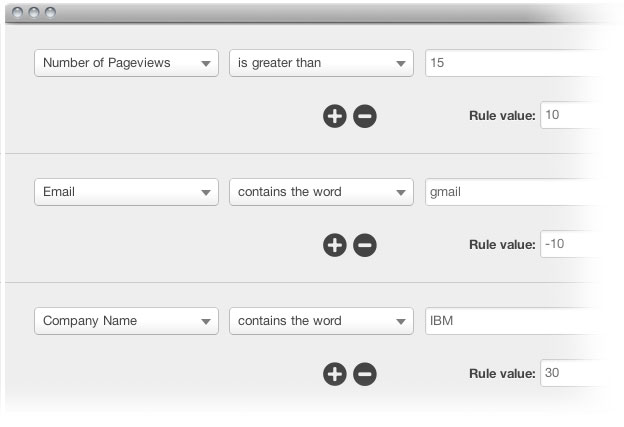If you have a well-established pipeline of leads coming in each month, you probably know what a challenge it can be to figure out where leads are in the funnel, and to prioritize the right leads to follow up with. What constitutes a lead that should be sent to sales versus a lead that needs more warming? Within that bucket of leads that aren’t ready for sales, are there meaningful subgroups? And how can we surface very hot leads who we should be dropping everything else to reach out to right away?
This is where lead scoring can be helpful, and HubSpot has you covered with an all new custom lead scoring system that is built right into our Contacts database.
We’ve spent a lot of time and done a lot of thinking about how to build a customized scoring system that’s both easy to use and incredibly powerful. With Contacts Lead Scoring, you can easily craft a customized set of scoring criteria that takes everything you know about your contacts into account. Assign point values to virtually any data you’ve collected on a lead, or actions your leads are taking on your website, in emails, even via social media.

Power through integration
You know that different leads interact with you in different ways - some are heavy browsers of your website and regularly submit forms, while others respond well to email or social media. Contacts lead scoring makes it possible for you to bring together touches from all of these different channels under one single score. Here are some examples of the different touch points that Contacts lead scoring works with -
- Any information you’ve collected through forms or data from an integrated CRM system. If you can dream it up and add it to a form, you can use it to score your leads. Maybe you want to add points if a leads’ job title contains a specific word like “director”, or if a lead is coming from a particular company. You could even subtract points if a leads’ email address ends in something like “@gmail.com”.
- Social media metrics. Just because some leads prefer to interact with you through channels like social media that are typically hard to quantify doesn’t mean that you should be ignoring them. HubSpot can score leads based on things like Twitter follower count, Facebook clicks, or LinkedIn clicks.
- Imported data from offline sources. Do a lot of time on the trade show circuit? Don’t let all that badge scanning and kiosk setup go to waste. By importing lists from your tradeshow, you can easily add new contacts to HubSpot, and drive up the lead scores of people who are already in your database.
- Analytics data like first page seen, referring website, or referring keyword. Add points to leads if they initially found your site by searching for a keyword that you know signals an intent to buy.
- Engagement metrics like number of emails opened or clicked, number of visits, pageviews, or forms submitted. Sum up granular interactions like page views, form submissions and email opens.
Grows with you over time
We’ve built Contacts Lead Scoring so that it’s easy to modify and change over time. By updating the scoring criteria you are using or adding new criteria, you’ll automatically update the scores for all of your contacts. This seemingly simple feature ensures that your lead scoring system scales as your marketing program grows.

Interested in giving Contacts Lead Scoring a try? It’s live for all HubSpot customers who have access to our Contacts database - just go to the settings screen in Contacts. If you are a HubSpot customer and don’t yet have access to Contacts, you can learn when you'll be migrated from the Customer Migration Center.